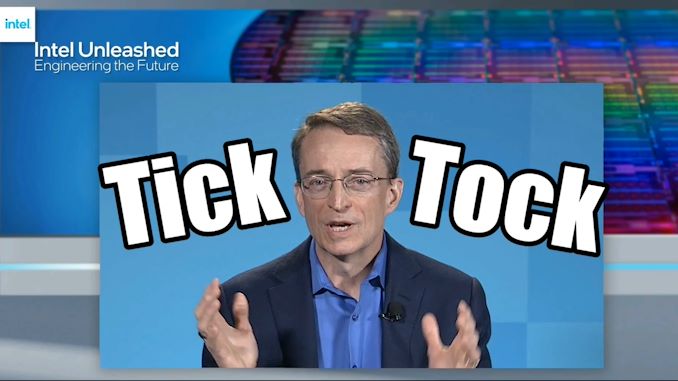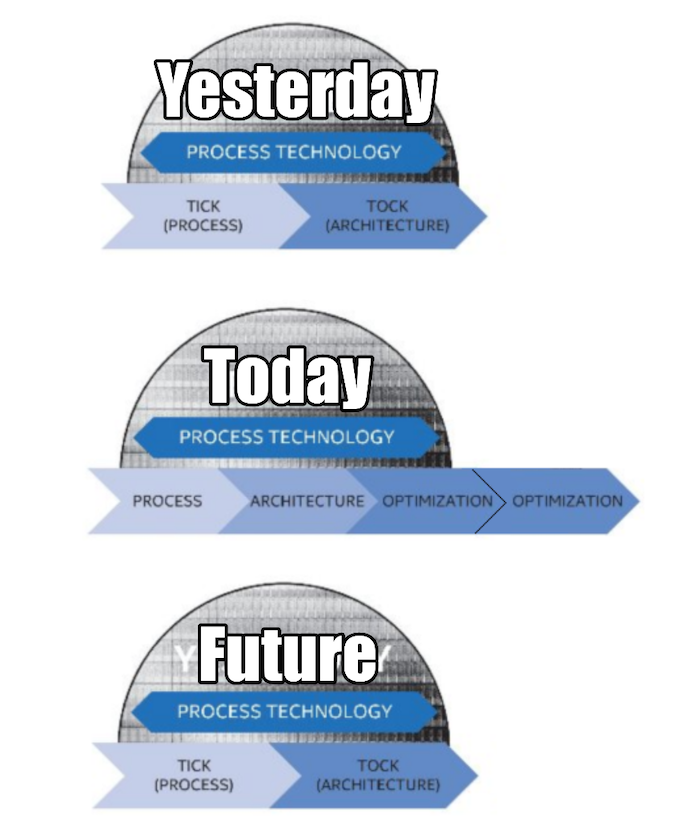Intel to Revive ‘Tick-Tock’ Model, Unquestioned CPU Leadership Performance in 2024/2025
by Dr. Ian Cutress on March 23, 2021 6:31 PM EST- Posted in
- CPUs
- Intel
- Tick-Tock
- 7nm
- Chiplets
- Pat Gelsinger
- Meteor Lake
- Tiles

As part of today’s announcements, during Intel’s Q&A session after the prepared remarks, CEO Pat Gelsinger explained how Intel is going to revive its fortunes when it comes to its leading edge compute products. One of Gelsinger’s mantras seems to be that unquestioned leadership products bring unquestioned leadership margins for those products, and for Intel to execute, it needs to return to its days of old.
In the past, through the 1990s, 2000s, and into the 2010s, Intel’s manufacturing philosophy was known as ‘Tick-Tock’. This means that for every product generation, the leading edge compute hardware was either a Tick (process node enhancement), or a Tock (microarchitecture enhancement). Each generation would alternate between the two, allowing Intel to take advantage of a familiar design on a new process node, or using a mature node to enable a new performance-focused design. That policy was scuppered when delays to Intel’s 10nm forced Intel into more of a Tick-Tock-Optimization-Optimization-Optimization model.
Today CEO Pat Gelsinger stated that at Intel’s core it has to re-establish the Tick-Tock model that enabled repeated leadership in the CPU ecosystem, buoyed by a healthy CPU roadmap. Part of this is re-establishing discipline in Intel’s ranks to continually provide both microarchitecture updates and process node updates on a regular expected cadence. Pat stated as part of the call that Intel will look towards a confirmed yearly process node improvement, and as a result, there might be a lot of Ticks in the future, with a push to more Tocks as well.
On top of this commentary, Pat Gelsinger also stated that Intel’s CPU roadmaps are already baked in through 2021, 2022, and 2023. The company is thus looking to 2024/2025 for ‘unquestioned CPU leadership performance’, which traditionally means the fastest processor for single thread and multi-thread workloads. This is for sure a laudable goal, however Intel will also have to adapt to a changing landscape of chiplet processor designs (coming in 2023), enhancing on-die accelerators (GNA already present), and also what it means to have leadership performance – in the modern era, leadership performance doesn’t mean much if you’re also pushing lots of Watts. Intel stated that its 7nm process is now comfortably on track to deliver Meteor Lake, a client CPU using tiles/chiplets, in 2023, however we are likely looking to a 7nm variant or even external processes for a 2024/2025 product. Intel has also stated that it is looking to consider the core of its leading edge compute on external foundry processes, although one might argue that this doesn’t explicitly say ‘CPU’.
It is also worth noting that Intel/Gelsinger isn’t calling its disaggregated silicon as ‘chiplets’, and prefers to use the term ‘tiles’. This is because Intel’s tiles amount to long wires across 3D packaging technologies like EMIB and Foveros, compared to package-based multi-die interconnect that require buffers as well as control fabric. Tiles by this definition are more costly to implement than chiplets, and have additional thermal considerations by having high-powered silicon close together, so it will be interesting to see how Intel balances these new packaging technologies with the more cost-sensitive elements of its portfolio, such as client processors.
It’s been known that Intel’s microarchitecture teams haven’t been idle waiting for 10nm to come through the pipe, with a number of designs ready and waiting to go for when the process node technology matures. With any luck, if Intel can get a headwind with 7nm, when 2024 rolls around it might all come thick and fast.











109 Comments
View All Comments
Spunjji - Friday, March 26, 2021 - link
100%shabby - Tuesday, March 23, 2021 - link
What is this new ceo on? 😂Techie2 - Tuesday, March 23, 2021 - link
He thinks he's back in the 80's. ;)Santoval - Wednesday, March 24, 2021 - link
"Intel stated that its 7nm process is now comfortably on track to deliver Meteor Lake, a client CPU using tiles/chiplets, in 2023, however we are likely looking to a 7nm variant or even external processes for a 2024/2025 product."Meteor Lake (on a brand new 7nm process node with brand new Ocean Cove "big" cores - the tiles thing is also brand new) will almost certainly be released on Q1 2024 at the earliest, thus the 2024/2025 timeline for ‘unquestioned CPU leadership performance’. If Ocean Cove cores on a new very efficient 7nm process node that is slightly denser than TSMC's 5nm process node (at the maximum density variant of both) cannot beat Zen 5 -they will almost certainly beat Zen 4 but I strongly doubt Ocean Cove will compete with that- then nothing can.
I expect Intel *will* fab 7nm parts in 2023 (though nothing in 2022), just not Meteor Lake. They never fab their premiere desktop parts on new nodes. They tend to fab mobile parts with up to 4 cores and up to 15 - 20W TDPs, so that the customers themselves do the final testing and debugging of the new node "in the wild". They might also fab some 7nm GPUs in 2023, though not the enthusiast or server ones. Up to mainstream class tops.
Otritus - Wednesday, March 24, 2021 - link
AMD doesn't have the resources to build a new microarchitecture every year. If Zen 4 is 2022, then the next major microarchitecture update would be 2024. If Ocean/Redwood cove is 2023, then Intel can bring a new microarchitecture 2025, which would beat Zen5+/6 (whatever AMD calls it). Remember that the microarchitecture for 7nm would be complete in 2022/2023, so even if Ocean Cove is delayed to 2024, it's possible for Intel to tock for 2025. I do agree that it is unlikely that Intel beats AMD's post Zen 4 big architecture in 2024, but 2025 should be competitive.Spunjji - Friday, March 26, 2021 - link
Aren't Intel supposed to be putting their Ponte Vecchio HPC GPU out as one of the (if not the) first products on 7nm?My best guess on why is that, after the abject failure and cost-soak of trying to manufacture tiny dual-core mobile chips on OG 10nm and failing, they've gone for a strategy that will probably pay for itself no matter how few GPU tiles they can yield from each wafer.
The big tell will be how fast they can move from pushing out a trickle of server-grade parts for a supercomputer project to ramping consumer parts that actually require decent yields to be profitable.
Silver5urfer - Wednesday, March 24, 2021 - link
I want what Gelsinger is smoking right now. What a comedy show... Tick Tock ? As much as I wanted to see it come. Its simply not possible now. Intel squandered their 5 year advantage of Fab Lithography edge long time back. Their true age was FinFet Haswell and 14nm debut in 2014. That's 6 years ago we are still in 14nm++ yes its very much optimized but its over for them.This guy saying x86 licensing, IP like EMIB (AMD G processors does anyone remember ?) And Foundry business. What the fuck ? Intel backport failed with RKL on Cypress Cove and 14nm++ now they want all of that licensing money by selling out their top x86.
Next this guy says High performance in 2024, by that Time even Apple might ship a server ARM alternative if we want to use ladders in sky type of talk. To be realistic AMD in 2024 is Zen5 probably on TSMC 3nm. And Intel doesn't even have 7nm by that time. Add Samsung GAAFET 3nm so who wants 7nm ? ARM processors will not for sure. Apple won't either. Altera ? Graviton ? Or that MS ARM server CPU ? Haha.
Man this guy is really all talk. First show us a successor for X299 then we talk.
Rudde - Wednesday, March 24, 2021 - link
Zen 5 is unlikely to be on 3 nm. Zen 6 on the other hand.drexnx - Wednesday, March 24, 2021 - link
Haswell was neither the first 14nm processor, nor was it the first finfetIVB was 22nm and finfet debut, and Broadwell was 14nm debut. That Intel initially had so many problems with 14nm at high power was an ill omen for their 10nm process (Broadwell-C was the only official desktop variant, and it was capped at 65w)
Silver5urfer - Wednesday, March 24, 2021 - link
Yeah, I didn't mention Broadwell which is a mistake by omission, I was in bed. BWL was 14nm debut yes and 22nm FinFet on IVB which I completely forgot.